Imaging techniques, such as an MRI scan, can reveal lumbar spine problems including bulging or herniated discs, facet joint arthritis (wear and tear), spondylolisthesis (slippage of one or more vertebra), scoliosis (curvature of the spine), post-surgical scar tissue or a combination of these factors. These pathologies may cause nerve root compression (trapped nerve) or irritation to one or more of the spinal nerve roots (lumbar radiculopathy) resulting in buttock and / or leg pain, often referred to as sciatica.
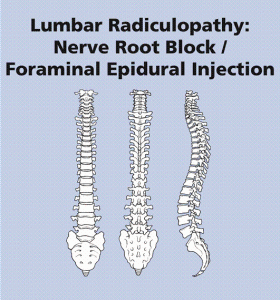
Example of a disc problem
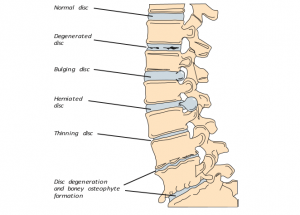
Diagram showing spondylolisthesis at L4 / L5
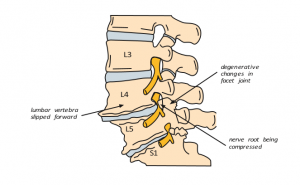
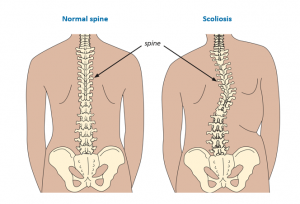
The normal spinal column has a central canal (passage) through which the spinal nerves pass down. At each vertebral level, spinal nerve roots branch out to each side. The solid spinal cord stops at the top of the lumbar spine (lower back) and from this point the nerves to the bottom and legs pass through the lower canal like a horse’s tail (cauda equina). The spinal cord, cauda equina and nerve roots are all surrounded by cerebrospinal fluid (CSF) and contained within a membrane, or covering, called the dura mater, rather like the thin layer that covers a boiled egg. There are five bones (vertebra) in the lumbar spine. In between each bone is an intervertebral disc which acts as both a spacer and a shock absorber. The disc is composed of two parts: a soft gel-like middle (nucleus pulposus) surrounded by a tougher fibrous wall (annulus fibrosus).
Overhead view of an intervertebral disc (simplified)

Overtime the intervertebral discs lose their flexibility, elasticity and shock-absorbing characteristics (disc degeneration). As the disc degenerates, it can become thin and the bony canal for the nerve root closes down. Sometimes, the tough outer layer of ligaments that surrounds the intervertebral disc may weaken and tear, causing the central gel to bulge into the nerve canal (termed a disc protrusion or prolapse). Both conditions can cause nerve inflammation and are the commonest reason for nerve root pain
(sciatica).
A nerve is like an electrical wire. It tells your muscles to move and gives your brain information about various sensations such as pain, temperature, light touch, pressure sensation and position of your legs. Nerve root pain is felt in the area of the body that the nerve, as it leaves the spine supplies. Symptoms may include pain, pins and needles, numbness, increased sensitivity or some weakness of the muscles in the leg and/or foot and toes.
Very few people who have sciatica, particularly due to a disc protrusion, need surgery. In the first 6 – 8 weeks of having symptoms a significant number of people will get better naturally. This can happen if the disc or swelling around a nerve decreases naturally (with time). Approximately 60% of patients can get better spontaneously by six weeks. 70 – 80% will feel better by three months.
Immediate spinal surgery is only necessary in cases of bladder or bowel incontinence (cauda equina syndrome) or progressive neurological problems such as paralysis or extreme weakness. In these cases, urgent medical assessment is required.
However, it is vital that seek medical attention or attend the emergency department if you develop any red flag symptoms which include the following;
- Numbness around the saddle area (genitals, buttocks, between the legs)
- Urinary difficulties such as poor flow, urgency, retention of urine, loss of sensation when urinating
- Sciatica-like pain in both legs, or weakness in the legs
- Sexual dysfunction or loss of sensation
Excess body weight will increase the load and pressure on the intervertebral discs and may exacerbate any structural problems causing an increase in symptoms. Losing weight may be beneficial if a patient is obese.
In general, most people with leg symptoms will get better over time, however, nerve root compression is a painful and debilitating condition and there is a balance between waiting whilst nature gets you better, versus waiting too long which might prolong your suffering and pain. So, in the short term, delivery of anti-inflammatory medicine direct to the source of irritation around the spinal nerve root is often beneficial and may provide excellent pain relief.
Nerve root block injections may also be performed as a diagnostic tool to help your specialist understand your condition. If there is pain relief following the injection, even if only temporary, it can confirm which nerve root was inflamed and the likelihood of whether the nerve pain could settle following surgery.
About the procedure
The procedure is often done under local anaesthesia (to numb the injection site and surrounding area). Your surgeon may decide that intravenous sedation (so the patient is unlikely to be aware) is required and may be given by an anaesthetist. You will be asked to lie down on the operating table on your stomach or side. The skin on the back is cleaned with antiseptic solution. A radiograph (X-ray) is then used to guide placement of a needle just outside the nerve root, close to where it leaves in between the vertebral bodies. Radiographic contrast (or dye) is often used to outline the nerve root before a small volume of corticosteroid (3 – 4 mls) and / or local anaesthetic is injected. It usually only takes 10 – 15 minutes to inject each painful nerve root, but for the whole procedure to include sedation, positioning, injection and x-rays the process will be longer.
We monitor for a minimum of 2 hours post procedure if sedation is used. If you have sedation you will be required to be nil by mouth (starved/fasting) 6 hours prior to your procedure. You may however drink water up to two hours prior to your injection. Please keep in mind you will be at the hospital for most of the day.
Usually patients are just admitted as a day case surgery as a rapid recovery from any sedation / anaesthetic is expected. Be aware that the local anaesthetic given may cause some temporary leg numbness or weakness for a few hours. You will need to be careful when getting out of bed, that any weakness does not cause your leg to ‘give way’ and for you to fall over.
Photo of spine model showing target point for the nerve block
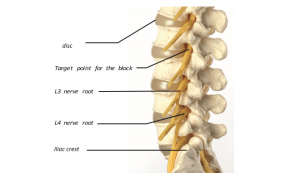
Once the numbness has worn off, it is not uncommon for the pain to return, occasionally slightly worse than before, until the corticosteroid takes effect. This can take several days or even a few weeks as steroid injections do take some time to work.
You should continue to take your usual pain relief medication until you begin to feel benefit. It is important not to stop taking certain pain relief medication suddenly, such as, morphine or neuropathic medication (gabapentin, pregabalin or amitriptyline). After an adequate period of time it will be time to assess pain relief and may be necessary to gradually ‘wean’ yourself off these medications – your consultant or GP can advise you if necessary.
60% of patients will experience significant benefits from these injections. However, the duration of benefit is variable and may last a few weeks, months or years. For a considerable number of patients, the injections can provide excellent pain relief during which time the disc swelling can reduce naturally. However, some patients who have had an episode of nerve root compression are at an increased risk of having a further episode. If an initial injection is helpful a surgeon may offer to repeat the procedure, but not usually for about six months.
If the symptoms have not improved after six weeks or the relief only temporary up to that point, then in certain circumstances, the next stage may be an operation to take pressure off the affected nerve root(s).
Risks and complications
Fortunately, there are very few risks associated with nerve root block injections. Very uncommon risks include:
- You must inform your consultant if you are taking tablets used to ‘thin the blood’, such as warfarin, rivaroxaban, clopidogrel and aspirin. It is likely you will need to stop taking these before your injection. If your procedure is scheduled with less than a week’s notice, please check with your consultant or nurse which drugs need to be stopped to prevent this being delayed
- Although this is rare, it is important that the skin on your back is clear of skin conditions like psoriasis or eczema as these can increase the risk
- facial flushing or, in women, interference with the menstrual cycle or post-menopausal bleeding. This can be a temporary side effect of the steroid
- a rise in blood sugar levels for a few days for people who have diabetes
- a needle injury to the dura (the membrane around the nerves). This is usually apparent at the time of injection and can result in a small leakage of the cerebrospinal fluid (CSF), which can lead to a headache (when standing and walking) for a few days afterwards. If this does occur, you may be advised to lie down for a period of time.
- allergic reactions to the medications or radiographic contrast (dye) used. Serious consideration is necessary for patients who are known to have chronic kidney disease (CKD) as the dye can adversely affect the kidney function, which is rare cases could lead to kidney failure.
- Risks of sedation. During your sedation your breathing may become slow, this is particularly common in deep sedation, but is a risk whenever sedation is used. Your anaesthetist is skilled in monitoring you and can support your breathing if required. It is very common that your blood pressure may drop by a small amount. It is very common to be left with a small bruise where your cannula was placed. Feeling sick or vomiting is uncommon. There is a small risk of stomach contents going into your lungs therefore it is vital to follow fasting instructions to keep this risk very low. Any allergic reaction to the sedation drugs is very rare. You may be at a higher risk of falling, especially if you are elderly. It is common for sedation to affect your judgement and memory for up to 24 hours.
What to expect on the day
Your admission time may be early (i.e. 07:00am) as it is likely that you are part of an operating list in theatres. The reason for this is, so all patient for that day can been seen by the anaesthetist and consultant. This also gives time for a comprehensive admission to the ward and getting changed ready for theatre. However, unavoidable things can happen on the day and they may be a wait. You will walk (if able to) to theatre with a ward nurse and porter to be checked in with the anaesthetist and theatre team.
After the injection, you will be taken to the recovery ward on your bed for a short while, where a nurse will check your blood pressure and pulse. Oxygen may be given to you through a facemask to help you wake up, if you were given sedation. You will then return to the ward. When ready you will be offered a light refreshment before you are discharged home.
Going home
You will normally be allowed home within a couple of hours of having had the injections, once you are able to walk safely, without the risk of falling because of the numbness in your leg(s). For people who have had multiple nerve root injections, this may mean staying longer, until the numbness begins to wear off.
If you have had intravenous sedation, then you will usually be monitored for around 1-2 hours on the ward depending on your sedation type and how you are feeling.
Please arrange for either a friend or relative to collect you from hospital. You must not drive on the day of the injections or if you have persistent weakness or numbness in your leg(s).
Work
You may be advised to take the next day off work, if you had intravenous sedation, however, you may feel that you need longer and if the pain persists. It can take several weeks before the full benefit of the injection takes place. The hospital can give you an off-work certificate, remember to request this during your admission or you can call the ward if you forget alternatively, you can ask your GP.
Driving
We advise that you avoid driving for a few days depending on how your symptoms are after your procedure. If you have no altered sensation and weakness in your legs and minimal pain, you may resume driving if you feel safe to do so, but you must be comfortable to do an emergency stop.
Follow-up
Your surgeon will advise you if you need to attend clinic after your procedure, or how to request a further clinic review if necessary. If you have any queries about the information in this booklet, please discuss them with the ward nurses or a member of your consultant’s team.
Information in this leaflet is based on research and revised by spinal nurse specialist Helen Vernau on behalf of the BASS Consent and Patient Information Committee. Illustration by Design Services at The Ipswich Hospital NHS Trust. Edited by Consultant Neurosurgeon Mr Rafid Al-Mahfoudh with permission from BASS.
